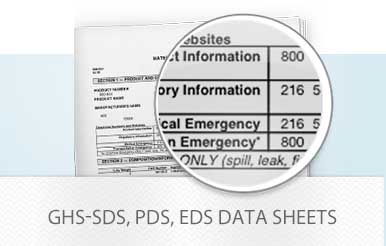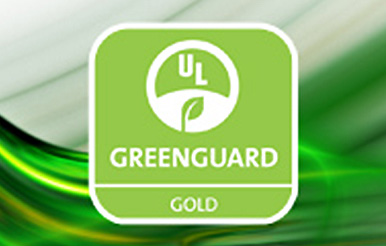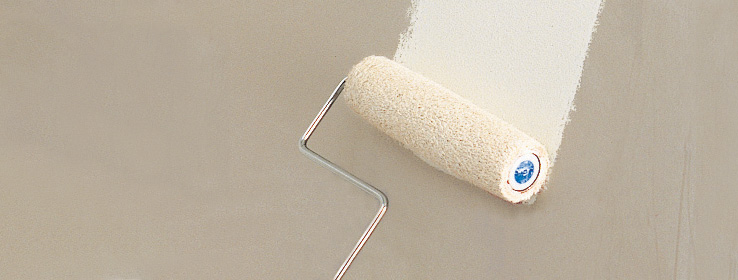Download the Green Programs & VOC Regulated Area Reference Guide for the latest list of Sherwin-Williams products that meet or contribute toward the guidelines set forth by each of these organizations
Leadership in Energy and Environmental Design (LEED®)
Leadership in Energy and Environmental Design (LEED®) green building certification program was developed by the U.S. Green Building Council (USGBC) to provide a consistent, credible set of standards for environmentally sustainable construction. The certification program consists of several different rating systems that each have their own project requirements for LEED certification, depending on the project or building type, such as schools, homes, healthcare facilities, or commercial interiors. Project requirements are divided into categories, allotting a certain number of credits that a project can "earn" in each category to satisfy green building requirements. For instance, "Materials & Resources" credits encourage using sustainable building materials and reducing waste, and the "Indoor Environmental Quality" credits promote better indoor air quality. The total number of credits earned in all categories determines a project's level of LEED certification.
This reference guide includes several LEED Rating Systems and lists the Sherwin-Williams products that contribute toward satisfying LEED's criteria under IEQ 4.2 Low Emitting Materials credit category under each system and others. Products are not reviewed or certified under LEED. LEED credit requirements cover the performance of materials in aggregate, not the performance of individual products or brands. Review the LEED Rating Systems included in this guide and then consult with a Sherwin-Williams Company Representative to ensure the most appropriate product selections for your next LEED®-registered project. For more information on LEED, visit www.usgbc.org.
Canadian Green Building Council (CaGBC)
This organization's mission is to accelerate the design and construction of green buildings in Canada by working to change industry standards, developing best design practices and guidelines, advocating for green buildings and developing educational tools to implement sustainable design and construction practices. Like USGBC, CaGBC offers a number of LEED® Canada rating systems to meet the needs of different building and project types, and allows paints and coatings to be used to earn credits as low emitting materials in the Indoor Environmental Quality Category. For more information visit: www.cagbc.org
National Association of Home Builders (NAHB)
A collaborative effort between the International Code Council (ICC) and NAHB, the National Green Building Standard™ ICC 700-2012("NGBS") is the only residential green building rating system approved by ANSI as an American National Standard. The NGBS provides practices for the design and construction of all types of green residential buildings, renovations, and land developments. The green aspects of the NGBS include lot design, preparation and development; resource, energy and water efficiency; indoor environmental quality; and operation, maintenance and building owner education. For more information visit: www.nahb.org
The Green Globes
Green Globes is a online assessment and rating system is used in Canada and the USA. In the USA, Green Globes is operated by the Green Building Initiative (GBI). The Green Globes system uses an online questionnaire-based approach. Once the questionnaire has been completed, a report is automatically generated, which provides ratings, a list of achievements as well as recommendations. The largest number of points in the Green Globes system are dedicated to energy. Green Globes serves as a virtual consultant, providing instant feedback on the environmental aspects of a structure's design along with advice and resources for improvements. Certification is achieved by undergoing third-party verification by trained regional verifiers. To receive a final rating of one, two, three or four globes, the data submitted online must be verified by a trained and licensed engineer or architect with significant experience in building sciences and sustainability. For more information, visit: www.thegbi.org
Master Painters Institute™ (MPI)
The MPI's Green Performance® Standard (GPS-1-12) requires that the manufacturer demonstrate that VOC concentrations of the product shall not exceed those listed at paintinfo.com
MPI Green Performance® Standard (GPS-2-12) provides for a maximum allowable limit of 50 g/L of VOCs.
MPI's X-Green PPerformance Standard simplifies the process of specifying environmentally-safe interior high quality architectural coatings by establishing ‘X-Green' editions of MPI's existing paint categories. X-Green certification requires performance i.e. as it relates to durability; VOC <50 g/l; reduced or zero quantities of various undesirable chemical components; and certification of emissions compliance to CHPS (Collaborative for High Performance Schools). Paint suppliers who already have products approved in an MPI paint category can be listed in the corresponding X-Green category by meeting MPI's GPS-2 requirement, which requires a maximum 50 g/l VOC, and submitting third-party test results verifying they meet CHPS emission requirements. For more information visit: www.paintinfo.com
GGHC Green Guide for Health Care™
According to GGHC,this is "the health care sector's first quantifiable sustainable design and facilities operations toolkit integrating enhanced environmental and health principles and practices into the planning, design, construction, operations and maintenance of their facilities. This Guide provides the health care sector with a voluntary, self-certifying metric toolkit of best practices that designers, owners, and operators can use to guide and evaluate their progress towards high performance healing environments." For more information visit: www.gghc.org/
CALGreen
According to CALGreen, "The 2013 California Green Building Standards Code is a code with mandatory requirements for new residential and nonresidential buildings (including buildings for retail, office, public schools and hospitals) throughout California beginning on January 1, 2014. The code is Part 11 of the California Building Standards Code in Title 24 of the California Code of Regulations and is also known as the CALGreen Code. In short, the code is established to reduce construction waste, make buildings more efficient in the use of materials and energy, and reduce environmental impact during and after construction." Sherwin-Williams offers a range of products that satisfy CALGreen's mandatory requirement of low VOC emitting materials. For more information visit: http://www.bsc.ca.gov/Home/CALGreen.aspx
ASHRAE
The American Society of Heating, Refrigerating and Air-Conditioning Engineers. Per ASHRAE “Standard 189.1 provides a “total building sustainability package” for those who strive to design, build and operate green buildings. From site location to energy use to recycling, this standard sets the foundation for green buildings by addressing site sustainability, water use efficiency, energy efficiency, indoor environmental quality, and the building’s impact on the atmosphere, materials and resources.” For more information visit: www.ashrae.org
IgCC™ International Green Construction Code™
Per IgCC™ "Internationally, code officials recognize the need for a modern, up-to-date code governing the impact of buildings and structures on the environment. This first edition, the 2012 edition, of the International Green Construction Code (IgCC™), is designed to meet this need through model code regulations that contain clear and specific requirements with provisions that promote safe and sustainable construction in an integrated fashion with the ICC Family of Codes". There are several states and cities within the United States that have adopted IgCC's mandatory building code requirements. For more information visit: www.iccsafe.org
California Air Resources Board (CARB)
Download Sherwin-Williams' CARB Specification
California's Legislature established CARB in 1967 to improve and maintain healthy air quality and conduct research into the causes of and solutions to air pollution in the State. CARB has authority to set and enforce emission standards for motor vehicles, fuels, and consumer products; set health-based air quality standards; monitor air quality; identify and set control measures for toxic air contaminants and oversee local air quality districts. To help control the State's significant smog levels, CARB has established much stricter regulatory requirements than most of the U.S. regarding VOC emission levels in hundreds of consumer products, including paints and other architectural coatings. For more information visit: www.arb.ca.gov
South Coast Air Quality Management District (SCAQMD)
Download Sherwin-Williams' SCAQMD Specification
South Coast Air Quality Management District (SCAQMD) is the air pollution control agency for Orange County and the urban portions of Los Angeles, Riverside and San Bernardino counties, the smoggiest region of the U.S. SCAQMD develops plans and regulations designed to improve air quality by reducing VOC emissions. These plans are then submitted for approval to the EPA and CARB to ensure compliance with their respective Clean Air Acts. Sherwin-Williams offers a range of paints and coatings that meet SCAQMD's strict regulatory VOC limits under Rule 1113. For further information visit SCAQMD's webpage: www.aqmd.gov
Ozone Transport Commission (OTC)
Download Sherwin-Williams' OTC Specification
The Ozone Transport Commission (OTC) is a multi-state organization created under the Clean Air Act (CAA). It is responsible for advising EPA on transport issues and for developing and implementing regional solutions to the ground-level ozone problem in the Northeast and Mid-Atlantic regions.
OTC brings together the states from Virginia to Maine to coordinate reductions in air pollution that benefit the whole region. The OTC provides air pollution assessment, technical support and a forum through which states can work together to harmonize their pollution reduction strategies. OTC members include: Connecticut, Delaware, the District of Columbia, Maine, Maryland, Massachusetts, New Hampshire, New Jersey, New York, Pennsylvania, Rhode Island, Vermont, and Virginia. If the project is located with in the OTC region, one must comply with the applicable VOC standards since each of the OTC states adopt their own rule. For more information visit: www.otcair.org
Ohio New VOC (Volatile Organic Compounds) regulations for paints went into effect on 1/1/09 in Ohio. These regulations are similar to those that have been implemented in the The Ozone Transport Commission (OTC) regions. Under the new regulations, lower VOC limits will be in effect for 54 coatings categories, such as flats, non-flats, primers, stains, varnishes and industrial maintenance coatings. All coatings sold, specified for use or used within the regulated areas must comply with these VOC limits. For additional information on the new VOC regulations, contact your Sherwin-Williams sales representative or local store manager or visit the Ohio EPA website at: www.epa.state.oh.us
Illinois enacted New VOC (Volatile Organic Compounds) regulations for paints that went into effect on 7/1/09. These regulations are similar to those that have been implemented in the The Ozone Transport Commission (OTC) regions. Under the new regulations, lower VOC limits will be in effect for 54 coatings categories, such as flats, non-flats, primers, stains, varnishes and industrial maintenance coatings. All coatings sold, specified for use or used within the regulated areas must comply with these VOC limits. For more information please visit: http://www.ipcb.state.il.us
Indiana New VOC (Volatile Organic Compounds) regulations for paints went into effect on 10/01/11 in Indiana. These regulations are similar to those that have been implemented in the The Ozone Transport Commission (OTC) regions. Under the new regulations, lower VOC limits will be in effect for coatings categories, such as flats, non-flats, primers, stains, varnishes and industrial maintenance coatings. All coatings sold, specified for use or used within the regulated areas must comply with these VOC limits. For additional information on the new VOC regulations, contact your Sherwin-Williams sales representative or local store manager or visit the Indiana website at: www.in.gov/legislative/iac
Canada
Canada's regulatory agency, Environment Canada, enacted new VOC (Volatile Organic Compounds) regulations for paints in September 9, 2010. The regulations apply to all general architectural and industrial maintenance coatings, and traffic marking products, that are made, imported, sold, or marketed in Canada. The Regulations set mandatory VOC concentration limits for 53 categories of architectural coatings. Concentration limits vary between 100 g/L–800 g/L depending on the category and are set out in the Schedule to the Regulations, which can be viewed at www.ec.gc.ca. Environment Canada is currently working towards adopting VOC regulations that align with those in the United States, particularly the more stringent regulations followed by CARB in California. It also intends to use the same product categories and definitions as those used in California. More information about Canadian VOC regulations for architectural coatings can be found at: http://www.ec.gc.ca/cov-voc/default.asp?lang=En&n=79D4AE5C-1. Since VOC regulations are constantly being reviewed and amended, it is important to consult with your Sherwin-Williams sales representative or local store manager to ensure compliance with the most current regulations.
GREENGUARD Environmental Institute (GEI)
The GREENGUARD Environmental Institute (GEI) strives to protect human health and quality of life by establishing standards and certification programs to reduce exposure to chemicals and to improve indoor air quality. GREENGUARD Certified products are certified to GREENGUARD standards for low chemical emissions into indoor air during product usage. For more information, visit ul.com/gg.
GREENGUARD'S IAQ Standard for Building Materials, Finishes and Furnishings is a nationally recognized voluntary standard that establishes requirements for qualifying paints and coatings as certified low-emitting products for indoor environments. Emission criteria are established for total VOC (TVOC), formaldehyde, total aldehydes, all individual chemicals with currently published Threshold Limit Values (TLVs), respirable particles and certain odorants and irritants. In addition, all products are screened and reported for carcinogens and reproductive toxins as listed by key government and regulatory programs.
GREENGUARD Children & Schools℠Standard for products intended for use in schools, daycares or other environments where children spend significant periods of time, the GREENGUARD Children & Schools Certification Program℠ offers stricter certification criteria. It is referenced by both The Collaborative for High Performance Schools (CHPS) and the Leadership in Energy and Environmental Design (LEED) Building Rating System. Products certified to this standard are also suitable for use in environments where children and others work, play or reside. GREENGUARD Children & Schools Certified products can be used to earn valuable credits in the CHPS Best Practices Manual for K-12 schools, the US Green Building Council's LEED® Green Building Rating Systems, the Green Guide for Healthcare, the NAHB Green Building Guidelines, Green Globes, Regreen and many other building codes, standards and specifications This reference guide also includes Sherwin-Williams products that have undergone GREENGUARD's rigorous testing and achieved certification under both the GREENGUARD Indoor Air Quality and the Children & Schools Standards. Further information and copies of certifications for Sherwin-Williams products can be obtained by visiting: www.greenguard.org.
Note: New GREENGUARD Marks combine the GREENGUARD and UL names: GREENGUARD Children & SchoolsSM, becomes GREENGUARD Gold. GREENGUARD IAQ becomes GREENGUARD certified.
Collaborative for High Performance Schools (CHPS)
"The mission of the Collaborative for High Performance Schools is to facilitate the design, construction and operation of high performance schools: environments that are not only energy and resource efficient, but also healthy, comfortable, well lit, and containing the amenities for a quality education. "CHPS helps facilitate and inspire change in our educational system. The goals of CHPS are to: Increase student performance with better-designed and healthier facilities, Raise awareness of the impact and advantages of high performance schools, Provide professionals with better tools to facilitate effective design, construction and maintenance of high performance schools, Increase school energy and resource efficiency, and Reduce peak electric loads." For more information visit: http://www.chps.net/dev/Drupal/node






